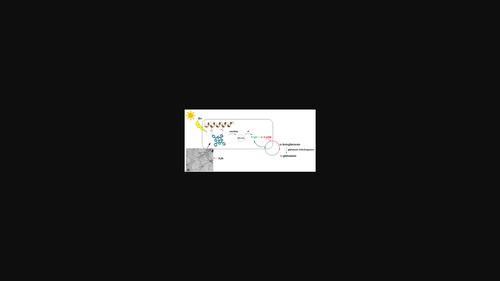当前位置:
X-MOL 学术
›
J. Pept. Sci.
›
论文详情
Our official English website, www.x-mol.net, welcomes your
feedback! (Note: you will need to create a separate account there.)
Toward cheaper light harvesting systems: Using earth-abundant metal oxide nanoparticles in self-assembled peptide-porphyrin nanofibers
Journal of Peptide Science ( IF 1.8 ) Pub Date : 2022-04-21 , DOI: 10.1002/psc.3413 Saurabh Lamba 1, 2 , Shinji Kihara 1, 2 , Eddie Wai Chi Chan 1, 2 , Duncan McGillivray 1, 2 , Geoffrey I. N. Waterhouse 1, 2 , Jadranka Travas‐Sejdic 1, 2 , Vijayalekshmi Sarojini 1, 2
Journal of Peptide Science ( IF 1.8 ) Pub Date : 2022-04-21 , DOI: 10.1002/psc.3413 Saurabh Lamba 1, 2 , Shinji Kihara 1, 2 , Eddie Wai Chi Chan 1, 2 , Duncan McGillivray 1, 2 , Geoffrey I. N. Waterhouse 1, 2 , Jadranka Travas‐Sejdic 1, 2 , Vijayalekshmi Sarojini 1, 2
Affiliation

|
Cheap artificial light harvesting systems, which competently harvest solar energy and promote efficient energy transfer, are highly sought after in the renewable sector. We report the synthesis of self-assembled peptide-porphyrin fibers (SJ 6) fabricated with iron(III) oxide (Fe3O4) nanoparticles as feasible electron acceptors. Charge-complementarity between the negatively charged peptide (20E) and the protonated Zn-tetraphenyl porphyrin (ZnTPyP) led to an ordered assembly of the ZnTPyP molecules, enabling efficient light harvesting. X-ray diffraction data indicates a more ordered structure in SJ 6 compared to 20E and ZnTPyP. The incorporation of Fe3O4 nanoparticles into SJ 6 showed significant fluorescence quenching, indicating efficient electron flow from the donor to the acceptor. The SJ 6-nFe3O4 system performed the light reaction of photosynthesis as confirmed by the reduction of 1 mM NAD+ to 0.180 mM NADH upon exposure to visible light (Xe lamp λ > 420 nm) for 1 h. The photochemical regeneration of NADH using the SJ 6-nFe3O4 system was coupled to glutamate dehydrogenase-catalyzed conversion of α-ketoglutarate to L-glutamate. These results confirm the successful synthesis of an artificial light harvesting peptide-porphyrin system with Fe3O4 nanoparticles as promising low-cost electron separators.
中文翻译:

走向更便宜的光收集系统:在自组装肽卟啉纳米纤维中使用地球上丰富的金属氧化物纳米粒子
廉价的人造光收集系统能够有效地收集太阳能并促进有效的能量转移,在可再生能源领域受到高度追捧。我们报告了自组装肽-卟啉纤维 ( SJ 6 ) 的合成,该纤维采用氧化铁 (III) (Fe 3 O 4 ) 纳米粒子作为可行的电子受体制造。带负电荷的肽 ( 20E ) 和质子化的 Zn-四苯基卟啉 (ZnTPyP) 之间的电荷互补性导致 ZnTPyP 分子有序组装,从而实现高效的光收集。X 射线衍射数据表明,与20E和 ZnTPyP相比, SJ 6中的结构更有序。Fe 3 O的掺入SJ 6中的4 个纳米颗粒显示出显着的荧光猝灭,表明电子从供体到受体的有效流动。SJ 6- nFe 3 O 4系统进行光合作用的光反应,这通过暴露于可见光(Xe 灯 λ > 420 nm)1 小时后 1 mM NAD + 减少至0.180 mM NADH得到 证实。使用SJ 6- nFe 3 O 4光化学再生 NADH系统与谷氨酸脱氢酶催化的α-酮戊二酸向L-谷氨酸的转化偶联。这些结果证实成功合成了具有 Fe 3 O 4纳米粒子的人工光捕获肽-卟啉系统,作为有前景的低成本电子分离器。
更新日期:2022-04-21
中文翻译:

走向更便宜的光收集系统:在自组装肽卟啉纳米纤维中使用地球上丰富的金属氧化物纳米粒子
廉价的人造光收集系统能够有效地收集太阳能并促进有效的能量转移,在可再生能源领域受到高度追捧。我们报告了自组装肽-卟啉纤维 ( SJ 6 ) 的合成,该纤维采用氧化铁 (III) (Fe 3 O 4 ) 纳米粒子作为可行的电子受体制造。带负电荷的肽 ( 20E ) 和质子化的 Zn-四苯基卟啉 (ZnTPyP) 之间的电荷互补性导致 ZnTPyP 分子有序组装,从而实现高效的光收集。X 射线衍射数据表明,与20E和 ZnTPyP相比, SJ 6中的结构更有序。Fe 3 O的掺入SJ 6中的4 个纳米颗粒显示出显着的荧光猝灭,表明电子从供体到受体的有效流动。SJ 6- nFe 3 O 4系统进行光合作用的光反应,这通过暴露于可见光(Xe 灯 λ > 420 nm)1 小时后 1 mM NAD + 减少至0.180 mM NADH得到 证实。使用SJ 6- nFe 3 O 4光化学再生 NADH系统与谷氨酸脱氢酶催化的α-酮戊二酸向L-谷氨酸的转化偶联。这些结果证实成功合成了具有 Fe 3 O 4纳米粒子的人工光捕获肽-卟啉系统,作为有前景的低成本电子分离器。











































 京公网安备 11010802027423号
京公网安备 11010802027423号